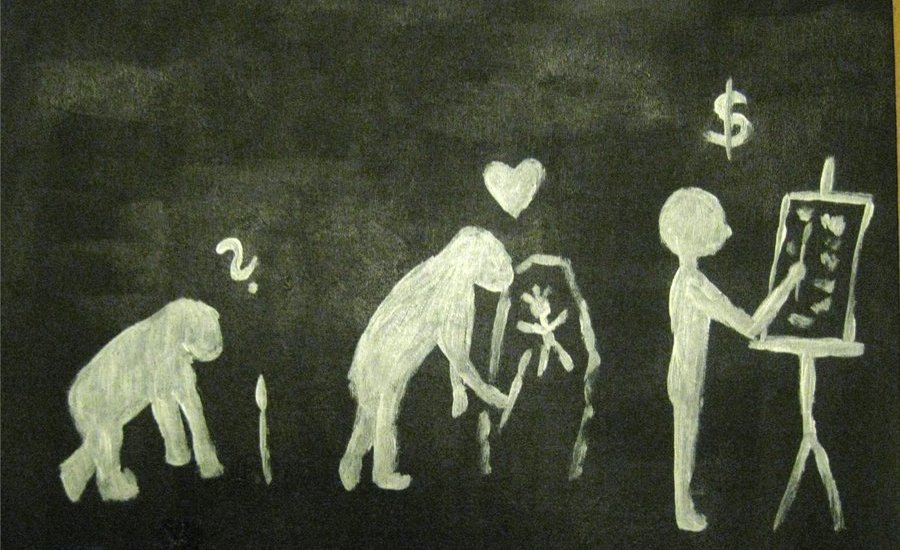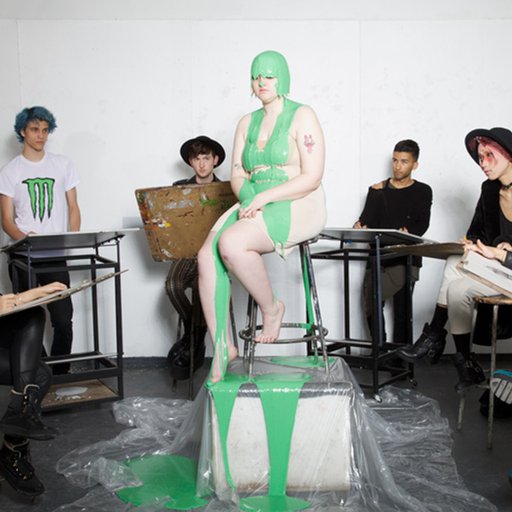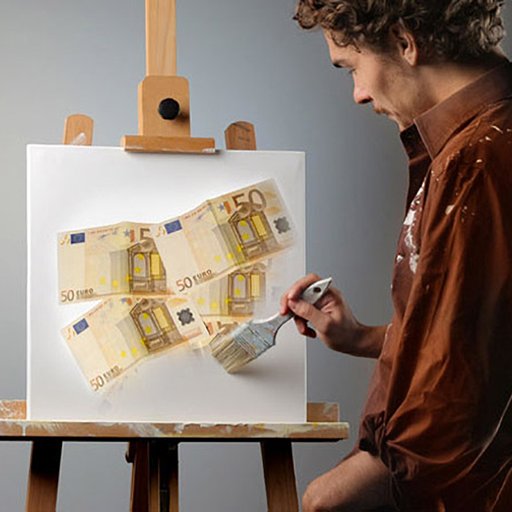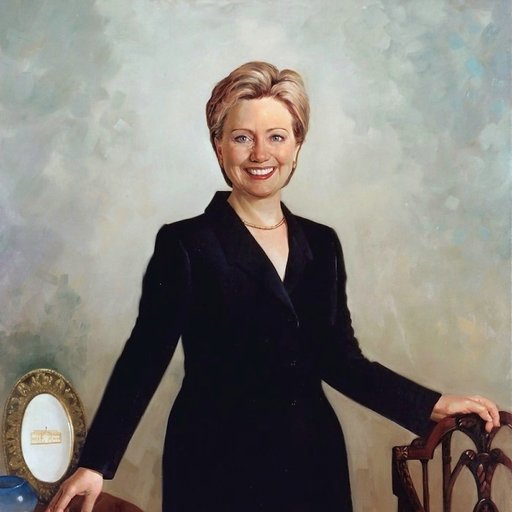In tumultuous political times like ours, artists and their audiences often become engaged in kind of of collective soul searching in an attempt to determine why, with so many real issues facing the world, we continue to make art in its current often abstruse, elitist form. These inquiries question the importance and impact of aesthetic pursuits, with some arguing that energy would be better spent on collective action and activism instead of creating, selling, and talking about things that only a very small segment of the population knows or cares about. This question—why do we make the art we do?—is vitally important if the art world is to continue its legacy as a vanguard of progressive culture.
That said, however, there is a deeper question that often goes unasked: why do we, as humans, make art at all? That is, why does our species pour time, energy, and resources into something with essentially no practical or functional value, creating objects that, while sometimes interesting and beautiful, do little to help us survive and reproduce (the apparent goals of every other creature on earth). This is an evolutionary as well as philosophical query, and one that’s puzzled biologists ever since Charles Darwin first published the seminal On the Origin of Species in 1859. If we follow the scientific community in accepting the theory of evolution through natural as the best explanation for why living beings behave the way they do, we need to be able to fit such mysterious phenomena as art into an evolutionary framework.
Luckily for us, there’s one institution that’s currently looking to tackle exactly this conundrum: Tasmania’s Museum of Old and New Art (Mona), founded by the Australian businessman, collector, and professional gambler David Walsh in 2011. The unusual museum is known as much for its aggressively postmodern architecture and out-of-the-way location as it is for its programming, which tends towards unexpected acquisitions and challenging curatorial conceits. Its current exhibition “On the Origins of Art” (on view through April 17) is a prime example: billed as a “crusade to piss off art academics,” the show features four interconnected exhibitions curated by some of the best-known (and controversial) evolutionary theorists of our time—Steven Pinker, Geoffrey Miller, Brian Boyd, and Mark Changizi—whose goal is to posit biological explanations as to why art has such an enduring grip on our species.
As is often the case when scientists attempt to elucidate aspects of human culture, their conclusions will rub many in the art world the wrong way, seeped as contemporary discourse is in a brand of postmodern critical theory that balks at any attempts at universal explanations for human behavior, claiming instead that such phenomena are wholly based in and the result of culture. For Mona, the show is a prime opportunity to shake the tacit assumptions of the art world and inject, sometimes none too gently, a dose of what they see as the empirical clarifications explaining why we love art so much. Here are several of the theories they propose.
Art as Cheesecake

The Canadian cognitive scientist Steven Pinker is perhaps the most famous thinker of the bunch, notable in this context for his 2002 book The Blank State: The Modern Denial of Human Nature, which disputes the “tabula rasa” account of humans as empty vessels without instincts or biological imperatives who simply absorb and reflect the society around them—a conception he says characterizes current thinking within the humanities.
Pinker argues instead that humans do indeed have innate mental tendencies, evolved via natural selection hundreds of thousands of years ago in the context of our origins on the prehistoric African savannah, that can be used to account for our behavior in the present day. (This idea, the starting point for all the other scientists discussed here, is a basic tenant of any evolutionary accounts of humanity.) If natural selection is the force behind evolution, this means that the actions of organisms (including Homo sapiens) are at base motivated by the need to pass on genetic material by producing offspring.
It’s important to understand that Pinker and his colleagues do not claim that every single thing we as humans do is directly aimed at making babies; this would make such phenomena as watching TV or playing solitaire difficult to explain. Rather, the idea is that our brains and bodies evolved to maximize reproductive fitness (the likelihood of producing viable offspring) and that the range of sometimes strange behaviors we display today are both made possible and limited by these physical structures.
This is the jumping off point for Pinker’s account in the “On the Origins of Art” catalog, which makes the case that the capacity for making art is likely not an adaptation unto itself, but rather a byproduct of other evolutionary developments. He starts by comparing our capacity for aesthetic appreciation to our ability to learn how to read. Clearly neither is a practical skill in our ancient savannah environment (written language, for instance, is only about 5,000 years old, too recent in the scope of our evolutionary history for any kind of physical mutation and subsequent natural selection to take place). Rather, the skill and its attendant pleasures arise from more basic evolved traits: the capacity for spoken language, the pleasures of pattern recognition, and the desire for contact with other members of our species. Combine all of these and, if properly nurtured, they give us the ability to produce great works of literature.
Put even more simply, humans have evolved large, highly mutable brains that can be applied to all manner of tasks beyond a direct pursuit of mates. This toolset is an evolved set of adaptations; what we build with the tools is largely up to us, and the cultural context we find ourselves in. That this communication technology (literacy) is preserved generation after generation is a testament to its continued usefulness, including in pursuit of mates. (Love letters, anyone?) It’s a concept that evolutionary biologists following the famed Stephen Jay Gould refer to as "spandrels," a term borrowed from the world of architecture to refer to the blank triangular space created by the outer curves of two arches when they meet. Though the spandrel is functionally a byproduct of the building’s design, it can be filled with decorative elements without altering its structural integrity. Art, Pinker argues, is a similar instance of perhaps unnecessary but nevertheless enjoyable decoration.
Pinker’s favorite analogy here is cheesecake, another example of something we humans make and enjoy consuming that we certainly didn’t evolve to create. What we did evolve, however, is a predilection for sugars and fats as high-energy foodstuffs. As we humans are wont to do, we’ve used our innate ingenuity to figure out how to intensify this experience, with cheesecake as a pinnacle of thousands of years of development (in this writer’s opinion, at least). Similarly, artworks take advantage of our sensitivity to and appreciation for colors, forms, and patterns, and complex narratives of all kinds—all evolved for purposes of expanding fitness—to produce artworks that we enjoy looking at and talking about.
Could we survive without cheesecake or Chuck Close? Of course, Pinker suggests, but we’re evolved to the point where we don’t have to make that choice.
Artists Are Sexy…

In contrast to Pinker’s gentle, aren’t-we-lucky-to-have-art take on the subject, the evolutionary psychologist Geoffrey Miller sees the creation of art purely in terms of sexual selection, the idea that organisms are constantly competing with members of their own gender for access to high-quality mates. He posits art as a signaling system, akin to birdsong or a gorilla’s chest-thumping, that show other members of the species one's fitness as a parent. Many species, including lions, chickens, and beta fish, prove their virility and defend their territory though physical combat. (Note that this is not the exclusive province of males; hyenas, for instance, live in matriarchal societies, where the alpha female enforces her mating rights over her underlings through violence and intimidation.)
In others species, however, this process is much subtler, with the quality of choreographed displays and songs (seen in many birds) or gifts of food (as with several species of spiders, among others) serving as proof that the would-be mate is up to snuff. In these cases, physical health is abstracted or symbolized by outward manifestations called “hard-to-fake signals” that indicate fitness. This, Miller says, is the evolutionary logic underpinning art-making through the ages.
This “handicap principle” has been well established in the literature on sexual selection ever since Darwin’s famous example of the male peacock, whose beautiful yet unwieldy tail feathers prove through their very existence his virility and capacity to evade predators. (The bigger the tail, the harder it is to fly away, meaning those who do must be especially strong, fast, and cunning.) In humans, the ability to spend valuable time carving marble, layering paint, or thinking through complex concepts signals a surfeit of resources and a nimble mind—attractive qualities in potential mates.
Miller argues that Pinker’s formulation addresses the recipient of the signal, but is weak when it comes to understanding why the artist spends so much time “making cheesecake,” as it were, sometimes to their physical detriment. Instead, he suggests that artists are, like the peacock, essentially showing off and strutting their stuff. By advertising their creativity, intelligence, mental fortitude, and wealth of time and materials, artists prove their worth to potential mates through hard-to-fake evidence of these positive traits: artworks, which have the added benefit of being something these potential mates like to look at anyway. Just think of how much your opinion of your coworker improves when they bring in a homemade cheesecake to share. Though you may not immediately want to ask them on a date, this rise in status for bakers makes the effort worthwhile—and the same applies to artists.
In Miller’s formulation, artworks are “extended phenotypes,” with "phenotypes" analogous here to “outward physical appearance.” A classic example of extended phenotypes in nature can be found among bowerbirds, a family of small Austronesian avians famous for the complicated and highly decorated “installations” that males build as stage sets to woo females. Though the male birds themselves are rather unremarkable and hard to distinguish from one another, the quality of the bower—filled with brightly colored berries, flowers, and, more recently, bits of trash, collected over the course of weeks—serves as a reliable indicator of the male’s fitness.
This is not to say that we evolved our appreciation for installation art from a prehistoric attraction to bowers. Rather, this is an example of convergent evolution, where similar evolutionary problems (how to select the best mate?) result in similar evolutionary solutions (check out their studio).
…But Collectors Are Probably Sexier

Brian Boyd, a professor of English at the University of Auckland who specializes in “Darwinian literary studies,” points out a central flaw in Miller’s account: “large-scale studies show that artists, unlike the flashiest peacocks, do not produce more offspring than average.” For a field looking to establish an empirical rather than emotional basis for their claims, this is a big problem for any account of art—clearly, this is not a cut-and-dry case of artists proving their fitness to potential mates. (Indeed, some would argue that frustrated or otherwise unrequited love is central to the creation many of humanity’s masterpieces.)
Boyd instead attempts to think through evolutionary psychology’s infamous bugbear—the apparently maladapted absurdities of culture—by looking at humans as fundamentally social animals that live, compete, and make art in multigenerational and multi-gender groups. Unlike the bowerbirds, who lead solitary lives outside the breeding season and produce their works for an audience of one, humans (both male and female) compulsively live together, meaning we make works for myriad reasons beyond simple sexual selection.
Boyd instead puts forward the idea that art is socially selected, with art that benefits the group being celebrated, preserved, and passed down over the ages. Instead of simply trying to impress potential partners, artists are instead looking for social recognition and respect, which in turn will lead to increased fitness. “Social selection,” Boyd writes, “can act powerfully within an ultra-social species like ours: from infancy we compete for favorable attention from others because we depend so much on one another.” Art is just one of the many pathways for distinguishing oneself while also winning favor within the group—and one that has expanded in importance as labor-reducing technologies continue to distance us from the life-and-death struggle for food and shelter. It’s something any regular visitor to gallery openings knows implicitly: showing up is more about the prestige of the scene than what’s on the wall.
This art appreciation goes two ways: artists have a social incentive to make art, but their audience (and, particularly in recent centuries, their collectors) also have evolutionary reasons for appreciating, talking about, and acquiring it. “Once art has become established as normal human behavior,” says Boyd, “individuals’ marked inability to respond to any art would be likely to be strongly socially selected against, to lead to their being shunned as unresponsive and dull, while artists of both sexes have powerful motivation to earn the admiration of many or all others in their group.” A healthy yet discerning appreciation for art suggests a viewer’s intelligence, sensitivity, and above all adherence to the beliefs and values of the group they find themselves in, principles that are presumably being expressed in one way or another through the artwork.
In this sense, art becomes part of the “extended phenotype” for appreciators of art, especially those with the means to commission and/or buy it themselves in what the early 20th-centuy social scientist Thorstein Veblen calls “conspicuous consumption.” In his section, Pinker puts this way: “only the wealthiest among us can throw money away on non-utilitarian ornaments and entertainments.” It’s not that that gold, gems, Gucci slippers, or van Goghs are intrinsically worth more than their less vaunted counterparts, but that various cultures have developed such that these objects become indicators of good taste and wealth—meaning, as we’ve discussed above, their owners probably make especially desirable mates. Think about that the next time a shoe that costs more than your rent stamps your foot at Art Basel.
On the other hand, this idea about the relativity of art’s content also helps to explain why seemingly unusual and culturally specific forms (the rise of decidedly hard-to-swallow Modernism in the West, or the lack of figuration in traditional Islamic art) arise and persist despite the fact that they don’t look like things we’ve evolved to enjoy (like pretty faces and tasty fruit, for instance). Abstract painting, for instance, has a certain social cachet in 2016 New York—the same is not true of New York in 1816, where presenting a color field as a work of art would likely earn consternation and rejection rather than praise. As a social group’s concerns and beliefs change, so do its aesthetics. Collectors, if they’re savvy, know to keep up with the times, buying works that prove their high status.
Boyd writes that “culture itself [is] a powerful inheritance system that works in the same way as genetic evolution, through variation, selection, and differential reproduction, through some ideas or designs spreading further and lasting longer than others.” Approaches to art that benefit the group endure and change over the years: this is art history. Beyond the simple cheesecake-like enjoyment we might get out of individual works of art, Boyd suggests that these pieces also function as potent vehicle for cultural transmission. By interpreting information seen as important to the group (from prehistoric cave paintings of sacred animals to conceptual projects challenging the political realities of the day), successful artworks are themselves selected for based on how effective they are in helping their audience get along as a group—and thereby, ultimately, pass on their genes. This informs the religious focus of most art though the 19th century, as well as the shifts towards more politically, socially, and individually driven content of the past century, which rose to fill the explanatory void left in the wake of Modernism. Culture, with all its strange and wonderful artifacts, is adaptive after all.
Art Holds a Mirror Up to Ourselves

On a similar note to Boyd, the fourth scientist-cum-curator, Mark Changizi, proposes a brand of cultural selection operating on artworks. His focus, however, is on the content, rather than context, of art. “Cultural artifacts don’t merely appear,” writes Changizi. “They evolve. They get shaped. They undergo selection pressure. Not natural selection, but cultural selection.”
His main criteria for determining whether a given artwork or style is selected for is how well it harnesses the evolved architecture of our brains to appeal to us. In its simplest form, this is Pinker’s cheesecake all over again: Changizi proposes that art operates through a system of “nature-harnessing,” where artists utilize stimuli (like patterns, colors, and emotions) we’ve adapted to respond to as a base substrate for art-making. We’ve evolved to pick up on patterns and cues from the people and natural world around us, meaning we’re using the same basic mechanisms when we’re looking at art, shopping at the grocery store, and noticing a beautiful stranger on the subway. (This may explain why music made with frequencies inaudible to the human ear or paintings that require thermal vision have yet to take off.)
Changizi takes all this a step further by postulating that, over and above all of our other concerns, we’re most closely attuned to stimuli that come to us from our fellow Homo sapiens. “You want your art to not only flow into human minds but also to cause really big waves?” he asks. “Then the key is to mimic the most important piece of furniture in our evolutionary habitat—people.” He sums up this “new narcissistic spin on art” in simple terms: “Art is just… ourselves.”
On a certain level, this makes sense: “Which sort of natural object matters most for daily survival? What sort of thing is most likely to kill you? With what kind of natural entity can we have sex and pass on our genes? People, people, people.” Artists and artworks harness this natural inclination to respond to people, making pieces that evoke on some level the actions of others and thereby become irresistible to viewers.
Based on his own statistical studies, Changizi takes music as his primary example, writing that “music has the structure of humans moving in our midst. But, presumably the music we like doesn’t simply sound like a human mover, but a human doing something really interesting, or novel, or evocative, or… artsy!” In other words, the sounds of our favorite tunes generally correspond roughly to interesting man-made noises and thus serve as emotionally evocative triggers for our senses. He admits, however, that his theory does little to account for the sheer diversity of visual art, or the ability to separate human-esque sounds from music proper, something most of us can do almost without thinking. If art really is just people seeing themselves in the warped funhouse mirror of art, Changizi and his followers have more work to do to prove it.
Conclusion: It’s Just Science, Silly

If reading this account has left you feeling a bit affronted, you’re not alone. Attempts by scientists to account for such deeply “human” concepts as aesthetic beauty have always generated strong responses from those who believe there’s more to us than our animal instincts. Claiming that we like art as a result of our desire to breed seems to take something away from the aesthetic experience itself: is our biology duping our minds when a work of art moves us? Again, however, the point must be stressed: to refute the idea that our behaviors are the result of millions of years of naturally selected adaptations is to challenge the theory of evolution itself, a position not dissimilar to climate-change denial. You may be right, but essentially every expert on the subject and over a century of extensive observation and testing say that you’re not.
As noted above, this is not to say that art is only about finding a mate and achieving social status, merely that our evolved tendency towards those basic aims is what gives us the tools to make art at all. One certainly can reduce paintings and sculptures to tools cynically (if subconsciously) used by artists and their collectors to gain status and tickle the brain of would-be mates in pursuit of passing on their genes, but to do so is to ignore the rich cultural contexts of the works: their complex and paradoxical meanings, their place in history, their interaction with other people and artworks, the expansive conversations and revolutionary actions they can engender. These things are just as real as the so-called survival of the fittest, and just as vital to our lives as humans.
In other words, complaining that evolutionary theory sucks the soul out of art is akin to saying an understanding of physics makes the night sky less beautiful. One of our greatest features as a species is the ability to use the raw materials of the world to craft stories that make sense to us. It’s an adaptation like any other—honed by natural selection on the African savannah over the course of millennia—that scientists and artists alike can wield for their own ends.
























